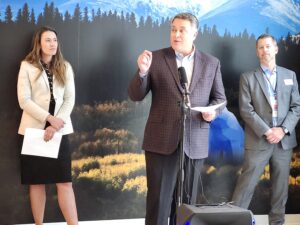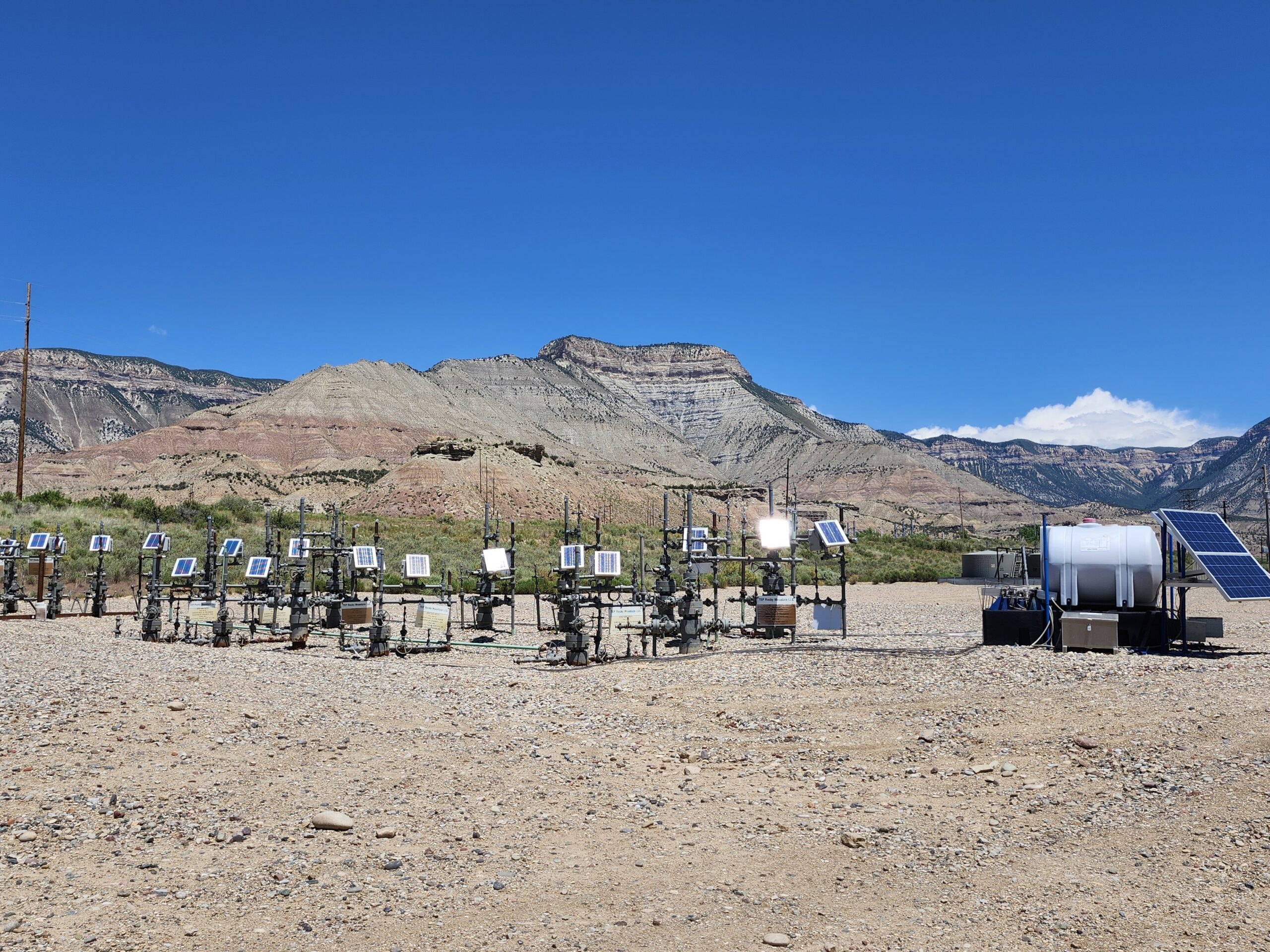Colorado state officials are moving forward with rules to reduce carbon dioxide emissions in yet another sector – this time the midstream sector of the oil and gas industry, a competitive area where both industry and environmental advocates are already concerned about the proposed regulations.
The midstream sector includes the pipelines and facilities that transport natural gas from sources to transmission companies that distribute it to power plants and homes. A key part of the sector – which in Colorado consists of three major players and a few dozen smaller companies – are the compression plants that move the gas through long pipelines to its destinations.
As part of efforts to reduce greenhouse gas emissions by 2030, state agencies have already issued regulations for a variety of industries, from manufacturing plants to large commercial buildings to gasoline-powered lawn equipment. They have developed rules for both upstream oil and gas production facilities, which extract resources from the ground, and some midstream oil and gas facilities. But these new rules specifically target the so-called industrial sector of the industry.
The rules for the industrial midstream sector have been in development for nearly three years, as it is considered one of the more difficult areas to decarbonize. Compressor stations and gas processing plants are often located in remote locations that require new power lines of eight to ten kilometers to handle the load for the electronification efforts – which is only possible if companies replace or retrofit large and expensive engines and boilers.
How the emissions cuts would work
Under the proposed rules, which will be formally heard before the Colorado Air Quality Control Commission from Dec. 18-20, midstream operators must reduce their emissions by 22 percent from 2015 levels by 2030 – a higher target than the 20 percent originally envisioned. While the target is sectorwide, specific emissions caps would be set on a company-by-company basis, explained Stefanie Shoup, director of the Colorado Department of Health and Environment’s Office of Innovations in Planning and Air Quality Assessment.
Department leaders want to create a cap-and-trade program similar to the one they are developing for the manufacturing sector, but they also want to require companies with operations in disproportionately affected communities to cut their emissions in those poorer or more polluted communities by at least 20 percent before they can use the new permits.
The goal, Shoup told AQCC members before their vote Thursday on the December hearing date, is to achieve emissions reductions in communities where they are most needed, in a way that is cost-effective and technically feasible. The rules, she added, should include provisions limiting penalties for scenarios outside an operator’s control, such as a utility’s inability to build the power lines needed to electrify a power plant in a timely manner.

Stefanie Shoup, director of the Colorado Department of Health and Environment’s Office of Innovations in Planning and Air Quality Assessment, speaks at an online meeting of the Colorado Air Quality Control Commission in August.
“Our intention is to make performance improvements where it makes the most sense for companies,” Shoup told commissioners. “From a regulatory perspective, that’s a much more difficult part (of the economy). Replacing fuel-burning equipment is a long-term issue and will take many years to come.”
Topics from the entire ideological spectrum
However, both industry leaders and environmental advocates expressed immediate concerns about the proposal.
The industry is particularly concerned because the rapid pace of the proposal imposes costly changes on operators and certain provisions could lead to a lack of flexibility.
To power facilities at remote power plants, midstream companies must build lines to those plants that can handle their large power loads. Officials estimate that some of those lines will need to be 10 miles long, at a cost of $1 million per mile. Then they must replace current diesel engines, which can cost around $750,000 each. On top of all of these costs, they are likely to face high monthly electricity bills.
In addition to the cost factor, there are also uncertainties about the electrical load – both in terms of how quickly utilities could reconnect plants to the grid and the availability of electricity. Utilities are prioritizing supply to homes over industrial plants, so compression and gas processing plants will have to line up behind new residential developments while assessing the availability of electrical equipment.
Do the cumulative effects of emission reductions need to be considered more thoroughly?
Finally, industry leaders worry that all of these costs and regulations, such as the inability to purchase credits to meet DIC caps, may not result in substantial emissions reductions—or may have other negative consequences. For example, if Western Slope midstream operators need to quickly transition to electrification, will they simply get their power from coal-fired plants in Wyoming? Or if the companies need to curtail production in disproportionately affected communities to meet the new caps, will they cut jobs in those communities and create other problems for local residents?

Colorado Oil & Gas Association President and CEO Dan Haley speaks about a series of new environmental laws at a press conference in February.
“Solving one problem could lead to a series of other negative consequences if the potential cumulative impacts of the policy are not considered and weighed,” Dan Haley, president and CEO of the Colorado Oil & Gas Association, said in a statement. “For example, if industries are displaced from these communities due to unworkable regulatory requirements, the stable jobs in the community could also be at risk – an outcome that would not benefit any community.”
Environmental organizations are already questioning whether the proposed rules will be sufficient to achieve the target of a 22 percent emissions reduction in the midstream sector by 2030.
Credit trading and disproportionately affected communities
Patricia Garcia-Nelson, a Colorado just energy transition advocate with GreenLatinos, served on a midstream committee advising CDPHE on potential sector rules. She said she has repeatedly warned against implementing a credit trading program. In addition to uncertainty about how such a program might work, she said she sees no evidence to support the department or industry’s claims that trading would help the state meet its emissions reduction goals faster.
CDPHE has not yet announced specific details of the trading program, but the idea is that regulated companies that meet their 2030 targets faster will be able to earn credits for reducing their emissions below their caps and then sell those credits to others. That could help companies that have a harder time feasibly reducing their emissions for a variety of reasons and would provide incentives for companies to go beyond simply meeting minimum targets because they could benefit from additional cleanup efforts.
But Garcia-Nelson said larger operators with the financial resources to make major improvements and emissions reductions would be allowed to use those funds to buy carbon credits instead, leaving surrounding communities dirtier. And while the rule requires at least 20% emissions reductions in DICs, more than 40% of the midstream sector’s emissions already occur in DICs, meaning the rules are unlikely to bring those areas on par with other parts of the state in terms of pollution, she said.

GreenLatinos and other groups distributed the signs before a press conference at the Capitol in February calling for new regulations to reduce emissions.
Further debate on emissions regulations planned
The proposed DIC language – which requires companies with one or more facilities in such communities to reduce their emissions by 20% but cannot purchase credits to meet their DIC cap – is problematic for industry leaders. Because the state defines a disproportionately impacted community as a census block that includes a high percentage of low-income residents, residents of color, or housing cost-burdened residents, roughly half of the state is a DIC, limiting flexibility in emissions reduction plans.
But environmentalists see the wording of credit trading as another reason for their fear that the government is undermining its stated goals by offering companies ways to comply with regulations that do not lead to actual emissions reductions.
“There’s no real indication of how this is going to help our communities. So to me it looks like this is really just benefiting the operators,” Garcia-Nelson said. “It’s very frustrating.”

